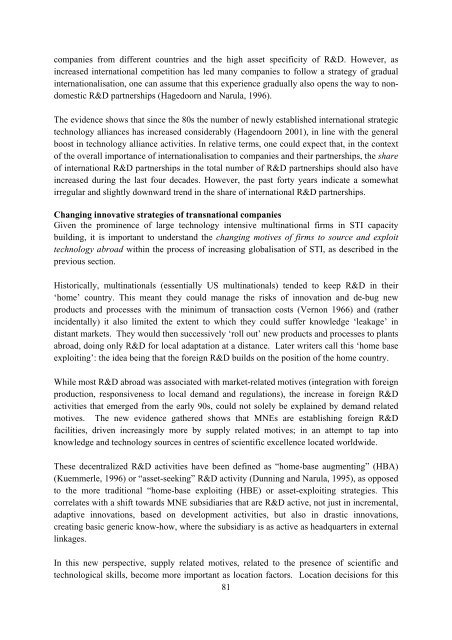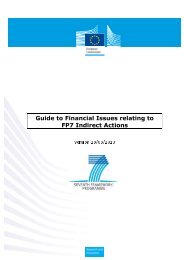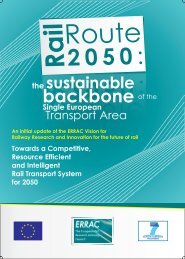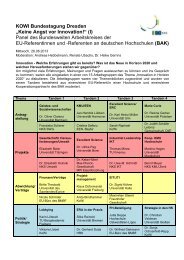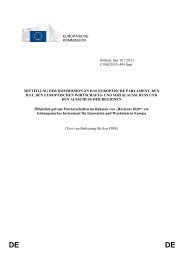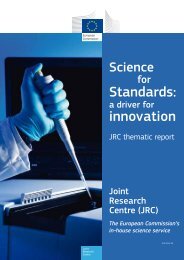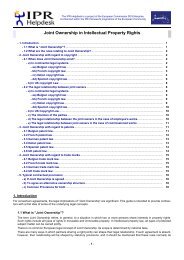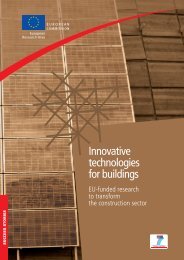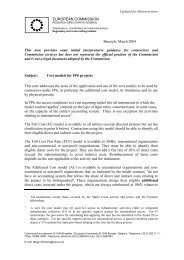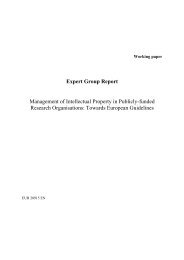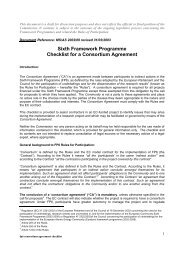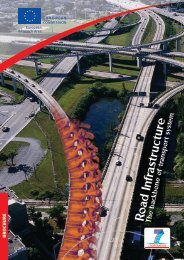Draft Report of the Expert Group on International STI Cooperation to ...
Draft Report of the Expert Group on International STI Cooperation to ...
Draft Report of the Expert Group on International STI Cooperation to ...
Create successful ePaper yourself
Turn your PDF publications into a flip-book with our unique Google optimized e-Paper software.
companies from different countries and <str<strong>on</strong>g>the</str<strong>on</strong>g> high asset specificity <str<strong>on</strong>g>of</str<strong>on</strong>g> R&D. However, as<br />
increased internati<strong>on</strong>al competiti<strong>on</strong> has led many companies <strong>to</strong> follow a strategy <str<strong>on</strong>g>of</str<strong>on</strong>g> gradual<br />
internati<strong>on</strong>alisati<strong>on</strong>, <strong>on</strong>e can assume that this experience gradually also opens <str<strong>on</strong>g>the</str<strong>on</strong>g> way <strong>to</strong> n<strong>on</strong>domestic<br />
R&D partnerships (Hagedoorn and Narula, 1996).<br />
The evidence shows that since <str<strong>on</strong>g>the</str<strong>on</strong>g> 80s <str<strong>on</strong>g>the</str<strong>on</strong>g> number <str<strong>on</strong>g>of</str<strong>on</strong>g> newly established internati<strong>on</strong>al strategic<br />
technology alliances has increased c<strong>on</strong>siderably (Hagendoorn 2001), in line with <str<strong>on</strong>g>the</str<strong>on</strong>g> general<br />
boost in technology alliance activities. In relative terms, <strong>on</strong>e could expect that, in <str<strong>on</strong>g>the</str<strong>on</strong>g> c<strong>on</strong>text<br />
<str<strong>on</strong>g>of</str<strong>on</strong>g> <str<strong>on</strong>g>the</str<strong>on</strong>g> overall importance <str<strong>on</strong>g>of</str<strong>on</strong>g> internati<strong>on</strong>alisati<strong>on</strong> <strong>to</strong> companies and <str<strong>on</strong>g>the</str<strong>on</strong>g>ir partnerships, <str<strong>on</strong>g>the</str<strong>on</strong>g> share<br />
<str<strong>on</strong>g>of</str<strong>on</strong>g> internati<strong>on</strong>al R&D partnerships in <str<strong>on</strong>g>the</str<strong>on</strong>g> <strong>to</strong>tal number <str<strong>on</strong>g>of</str<strong>on</strong>g> R&D partnerships should also have<br />
increased during <str<strong>on</strong>g>the</str<strong>on</strong>g> last four decades. However, <str<strong>on</strong>g>the</str<strong>on</strong>g> past forty years indicate a somewhat<br />
irregular and slightly downward trend in <str<strong>on</strong>g>the</str<strong>on</strong>g> share <str<strong>on</strong>g>of</str<strong>on</strong>g> internati<strong>on</strong>al R&D partnerships.<br />
Changing innovative strategies <str<strong>on</strong>g>of</str<strong>on</strong>g> transnati<strong>on</strong>al companies<br />
Given <str<strong>on</strong>g>the</str<strong>on</strong>g> prominence <str<strong>on</strong>g>of</str<strong>on</strong>g> large technology intensive multinati<strong>on</strong>al firms in <strong>STI</strong> capacity<br />
building, it is important <strong>to</strong> understand <str<strong>on</strong>g>the</str<strong>on</strong>g> changing motives <str<strong>on</strong>g>of</str<strong>on</strong>g> firms <strong>to</strong> source and exploit<br />
technology abroad within <str<strong>on</strong>g>the</str<strong>on</strong>g> process <str<strong>on</strong>g>of</str<strong>on</strong>g> increasing globalisati<strong>on</strong> <str<strong>on</strong>g>of</str<strong>on</strong>g> <strong>STI</strong>, as described in <str<strong>on</strong>g>the</str<strong>on</strong>g><br />
previous secti<strong>on</strong>.<br />
His<strong>to</strong>rically, multinati<strong>on</strong>als (essentially US multinati<strong>on</strong>als) tended <strong>to</strong> keep R&D in <str<strong>on</strong>g>the</str<strong>on</strong>g>ir<br />
‘home’ country. This meant <str<strong>on</strong>g>the</str<strong>on</strong>g>y could manage <str<strong>on</strong>g>the</str<strong>on</strong>g> risks <str<strong>on</strong>g>of</str<strong>on</strong>g> innovati<strong>on</strong> and de-bug new<br />
products and processes with <str<strong>on</strong>g>the</str<strong>on</strong>g> minimum <str<strong>on</strong>g>of</str<strong>on</strong>g> transacti<strong>on</strong> costs (Vern<strong>on</strong> 1966) and (ra<str<strong>on</strong>g>the</str<strong>on</strong>g>r<br />
incidentally) it also limited <str<strong>on</strong>g>the</str<strong>on</strong>g> extent <strong>to</strong> which <str<strong>on</strong>g>the</str<strong>on</strong>g>y could suffer knowledge ‘leakage’ in<br />
distant markets. They would <str<strong>on</strong>g>the</str<strong>on</strong>g>n successively ‘roll out’ new products and processes <strong>to</strong> plants<br />
abroad, doing <strong>on</strong>ly R&D for local adaptati<strong>on</strong> at a distance. Later writers call this ‘home base<br />
exploiting’: <str<strong>on</strong>g>the</str<strong>on</strong>g> idea being that <str<strong>on</strong>g>the</str<strong>on</strong>g> foreign R&D builds <strong>on</strong> <str<strong>on</strong>g>the</str<strong>on</strong>g> positi<strong>on</strong> <str<strong>on</strong>g>of</str<strong>on</strong>g> <str<strong>on</strong>g>the</str<strong>on</strong>g> home country.<br />
While most R&D abroad was associated with market-related motives (integrati<strong>on</strong> with foreign<br />
producti<strong>on</strong>, resp<strong>on</strong>siveness <strong>to</strong> local demand and regulati<strong>on</strong>s), <str<strong>on</strong>g>the</str<strong>on</strong>g> increase in foreign R&D<br />
activities that emerged from <str<strong>on</strong>g>the</str<strong>on</strong>g> early 90s, could not solely be explained by demand related<br />
motives. The new evidence ga<str<strong>on</strong>g>the</str<strong>on</strong>g>red shows that MNEs are establishing foreign R&D<br />
facilities, driven increasingly more by supply related motives; in an attempt <strong>to</strong> tap in<strong>to</strong><br />
knowledge and technology sources in centres <str<strong>on</strong>g>of</str<strong>on</strong>g> scientific excellence located worldwide.<br />
These decentralized R&D activities have been defined as “home-base augmenting” (HBA)<br />
(Kuemmerle, 1996) or “asset-seeking” R&D activity (Dunning and Narula, 1995), as opposed<br />
<strong>to</strong> <str<strong>on</strong>g>the</str<strong>on</strong>g> more traditi<strong>on</strong>al “home-base exploiting (HBE) or asset-exploiting strategies. This<br />
correlates with a shift <strong>to</strong>wards MNE subsidiaries that are R&D active, not just in incremental,<br />
adaptive innovati<strong>on</strong>s, based <strong>on</strong> development activities, but also in drastic innovati<strong>on</strong>s,<br />
creating basic generic know-how, where <str<strong>on</strong>g>the</str<strong>on</strong>g> subsidiary is as active as headquarters in external<br />
linkages.<br />
In this new perspective, supply related motives, related <strong>to</strong> <str<strong>on</strong>g>the</str<strong>on</strong>g> presence <str<strong>on</strong>g>of</str<strong>on</strong>g> scientific and<br />
technological skills, become more important as locati<strong>on</strong> fac<strong>to</strong>rs. Locati<strong>on</strong> decisi<strong>on</strong>s for this<br />
81


